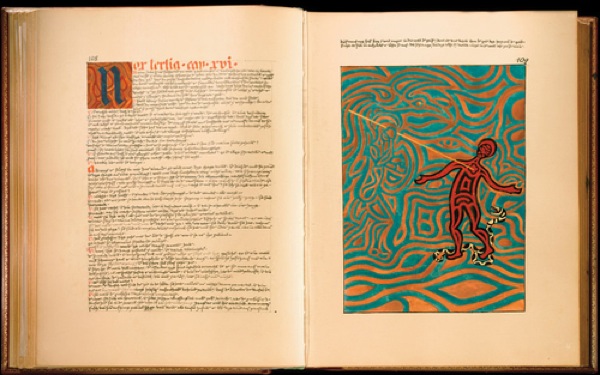
For more than 25 years, pioneer psychologist and seeker Carl Jung's Red Book was hidden away inside a Swiss bank vault. A huge lovely volume bound in red leather, also known as Liber Novus (The New Book), the book is essentially Jung's personal journals written in calligraphy and gorgeously illuminated during a very strange period in his life. I recently browsed through the Red Book, finally available to everyone in a breathtaking edition published by WW Norton & Company. The Red Book is a breathtaking travelogue from Jung's journey into his unconscious, and best enjoyed in small, powerful doses.
From Fortean Times:
It was Jung’s break with Freud that led to his own ‘descent into the unconscious’, a disturbing trip down the psyche’s rabbit hole from which he gathered the insights about the collective unconscious that would inform his own school of ‘analytical psychology’. He had entered a ‘creative illness’, unsure if he was going mad. In October 1913, not long after the split, Jung had, depending on your perspective, a vision or hallucination. While on a train, he suddenly saw a flood covering Europe, between the North Sea and the Alps. When it reached Switzerland, the mountains rose to protect his homeland, but in the waves he saw floating debris and bodies. Then the water turned to blood. The vision lasted an hour and seems to have been a dream that had invaded his waking consciousness. Having spent more than a decade treating mental patients who suffered from precisely such symptoms, Jung had reason to be concerned. He was ironically rather relieved the next summer when WWI broke out and he deduced that his vision had been a premonition of it. Yet the psychic tension continued. Eventually there came a point where Jung felt he could no longer fight off the sense of madness. He decided to let go. When he did, he landed in an eerie, subterranean world where he met strange intelligences that ‘lived’ in his mind. The experience was so upsetting that for a time Jung slept with a loaded pistol by his bed, ready to blow his brains out if the stress became too great.
In his Red Book – recently published in full – he kept an account, in words and images, of the objective, independent entities he encountered during his “creative illness” – entities that had nothing to do with him personally, but who shared his interior world. There were Elijah and Salome, two figures from the Bible who were accompanied by a snake. There was also a figure whom Jung called Philemon, who became a kind of ‘inner guru’ and who he painted as a bald, white-bearded old man with bull’s horns and the wings of a kingfisher. One morning, after painting the figure, Jung was out taking a walk when he came upon a dead kingfisher. The birds were rare in Zürich and he had never before come upon a dead one. This was one of the many synchronicities – “meaningful coincidences” – that happened at this time. There were others.

No comments:
Post a Comment